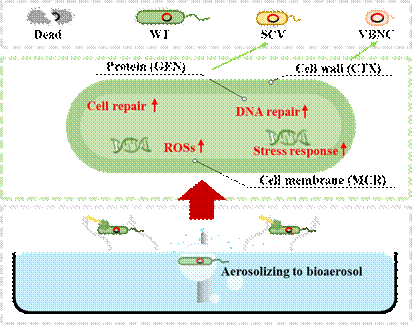近日,广东工业大学环境健康与污染控制研究院、环境科学与工程学院安太成教授团队在气溶胶化过程中生物气溶胶的响应与形成机制方面取得最新研究进展,研究成果以《Response and Formation Mechanism of Highly Antibiotic-Resistant Dormant Subpopulations in Bioaerosol during Aerosolizing from Aquatic Environments》为题发表在Environmental Science & Technology (2025, 59(41), 22145-22156; https://doi.org/10.1021/acs.est.5c06017)期刊上。论文的第一作者为博士生陈婷婷,第二作者为博士后蔡仪威,通讯作者为安太成教授和李桂英教授。本研究作者以多种抗生素耐药大肠杆菌为研究对象,深入地阐释了水体微生物在气溶胶化过程的表型变化、生化响应特征及分子机制,揭示了耐药细菌应对气溶胶化胁迫的适应策略。结果显示:耐药大肠杆菌生物气溶胶可通过携带耐药基因增强对气溶胶化胁迫的耐受性,并形成野生型、小菌落突变体(SCV)及活的但不可培养状态细菌(VBNC)亚群等多种表型。此外,不同耐药靶点菌株的休眠亚群分布存在一定的差异。SCV亚群普遍表现出生长代谢活性降低、ATP积累及活性氧(ROS)含量增加的特征,提示其是通过激活氧化应激响应抵御环境胁迫的生存策略。进一步机制分析表明:细胞壁合成基因上调可促进VBNC亚群形成,而蛋白质合成基因上调则可以驱动SCV亚群产生。耐药细菌可通过调控相关基因表达促进气溶胶化过程中休眠亚群的形成,这些亚群可能对微生物生态系统稳定性及人类健康构成差异化风险。本研究成果可为ARB在大气环境中的传播和演化提供新的见解,有助于推进对生物气溶胶形成和抗生素耐药性传播的研究,以减少耐药性转移。

论文的网址: https://pubs.acs.org/doi/10.1021/acs.est.5c06017
抗生素抗性细菌(ARB)及其携带的抗性基因(ARGs)的扩散已成为全球公共卫生领域的重大挑战。生物气溶胶作为ARB和ARGs的关键传播介质,能够经由呼吸道吸入、消化道摄入以及皮肤接触等多种途径进入人体。微生物可从食物垃圾、土壤和水体等不同环境介质中通过气溶胶化过程释放到大气中。尽管该过程广泛存在,但气溶胶化过程本身对微生物存活的影响及其内在机制尚不完全明确。此外,气溶胶化过程如何调控ARB的生存策略,以及携带不同ARGs的ARB在生物气溶胶产生过程中的响应机制仍不明确。因此,本研究旨在探究生物气溶胶中ARB的表型异质性、代谢活力、氧化应激反应及其抗生素抗性特征,重点阐明ARGs在大肠杆菌活性变化中的调控作用,并通过分析氧化应激、外排泵及代谢相关基因的表达,揭示ARB进入生物气溶胶状态过程中的适应机制,同时考察了ARGs在生物气溶胶中不同休眠亚群形成过程中的作用机制。本研究成果将深化对水生及大气环境中ARGs转化与传播规律的理解,同时为揭示生物气溶胶中ARB的环境适应机制提供一定的理论依据。
图文摘要

英文摘要:
The characteristics and responses of bacteria aerosolized from aquatic to atmospheric environments are poorly understood. In this study, three antibiotic-resistant bacteria (Escherichia coli DH5α (CTX), E. coli DH5α (MCR), and E. coli DH5α (GEN)) were used to explore microbial aerosolization responses and mechanisms. E. coli bioaerosols had improved resistance to aerosolizing stress through carrying antibiotic resistance genes, developing different phenotype distributions, including wild-type, small colony variant (SCV), and viable but non-culturable (VBNC) subpopulations. Cefotaxime (CTX)-resistant E. coli bioaerosols showed the highest percentage of VBNCs (15.1%), while those gentamycin (GEN)-resistant E. coli bioaerosols showed the highest percentage of SCVs (13.4%). Lower growth capacity, reduced metabolic activity, increased adenosine triphosphate accumulation, elevated intracellular reactive oxygen species, up-regulated protein synthesis-related genes, and enhanced gentamicin resistance were observed in GEN-resistant E. coli SCVs. Oxidative stress responses were activated to defend against stress and promoted the formation of dormant subpopulations. Up-regulation of cell wall synthesis genes promoted VBNC formation, while up-regulation of protein synthesis genes promoted SCV formation. These findings highlight that antibiotic resistance in aquatic bacteria contributes to the formation of different dormant subpopulations in bioaerosols that pose different risks to ecosystems and human health.
项目资助:本研究受到国家自然科学基金项目(42330702 和 42407291),广东省“珠江人才计划”引进创新团队项目(2023ZT10L102)的联合资助。